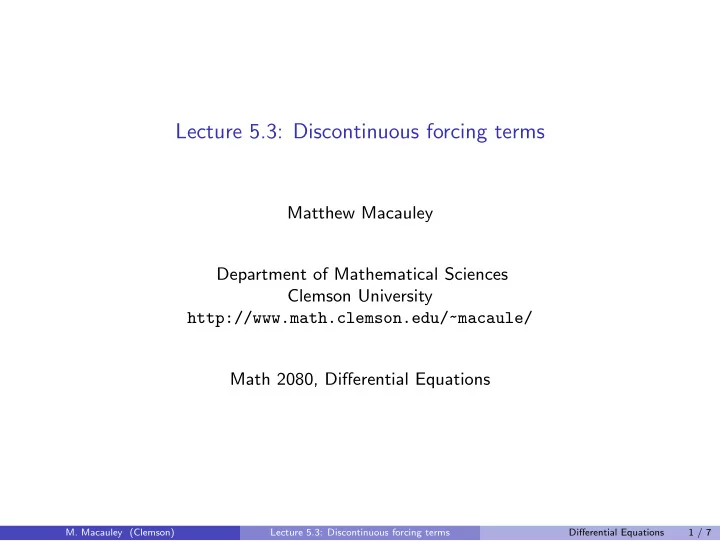

Lecture 5.3: Discontinuous forcing terms Matthew Macauley Department of Mathematical Sciences Clemson University http://www.math.clemson.edu/~macaule/ Math 2080, Differential Equations M. Macauley (Clemson) Lecture 5.3: Discontinuous forcing terms Differential Equations 1 / 7
Step functions Definitions 0 , t < a Interval function: H ab ( t ) = 1 , a ≤ t < b 0 , b ≤ t < ∞ � 0 , t < 0 Heavyside function: H ( t ) = 1 , t ≥ 0 � 0 , t < c Shifted Heavyside function: H c ( t ) = 1 , t ≥ c M. Macauley (Clemson) Lecture 5.3: Discontinuous forcing terms Differential Equations 2 / 7
Writing step functions using Heavyside functions Example 1 � 2 t , 0 ≤ t < 1 f ( t ) = 2 , t ≥ 1 Example 2 3 , 0 ≤ t < 4 f ( t ) = − 5 , 4 ≤ t < 6 e 7 − t , 6 ≤ t < ∞ M. Macauley (Clemson) Lecture 5.3: Discontinuous forcing terms Differential Equations 3 / 7
Shifted functions Key property If L{ f ( t ) } = F ( s ), then L{ f ( t − c ) H ( t − c ) } = e − cs F ( s ) M. Macauley (Clemson) Lecture 5.3: Discontinuous forcing terms Differential Equations 4 / 7
Shifted functions: L{ f ( t − c ) H ( t − c ) } = e − cs F ( s ) Examples Compute L{ ( t − 3) 2 H ( t − 3) } . Compute L{ t 2 H ( t − 3) } . Compute L{ e t − 1 H ( t − 1) } . Compute L{ e 7 − t H ( t − 6) } . M. Macauley (Clemson) Lecture 5.3: Discontinuous forcing terms Differential Equations 5 / 7
Shifted functions: L{ f ( t − c ) H ( t − c ) } = e − cs F ( s ) Example (revisited) 3 , 0 ≤ t < 4 Compute the Laplace transform of f ( t ) = . − 5 , 4 ≤ t < 6 e 7 − t , 6 ≤ t < ∞ Recall that f ( t ) = 3 H ( t ) − 8 H ( t − 4) + 5 H ( t − 6) + e 7 − t H ( t − 6). M. Macauley (Clemson) Lecture 5.3: Discontinuous forcing terms Differential Equations 6 / 7
ODEs with piecewise forcing terms Example � 2 t , 0 ≤ t < 1 Solve the IVP: y ′′ + y = f ( t ), y (0) = 0, y ′ (0) = 1, where f ( t ) = 2 , t ≥ 1 M. Macauley (Clemson) Lecture 5.3: Discontinuous forcing terms Differential Equations 7 / 7
Recommend
More recommend